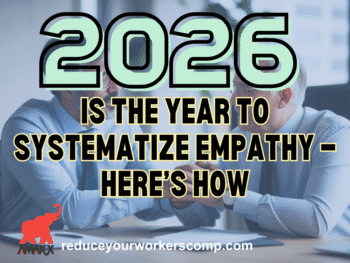
Post-Injury Response Is Key
Reducing the amount of money spent on a workers’ compensation claim starts immediately after an injury, and the employee is stabilized. When taking the following steps, interested stakeholders can demonstrate their commitment to an ethical process that drives workplace morale.
- Immediate application of the first aid and summoning emergency medical services if needed;
- Providing transportation to/from a medical provider if the injury requires something more than basic first aid but does not require the assistance of emergency medical services; and
- Regular and consistent post-injury follow-up that continues until the employee returns to work and fully recovers.
Additional things to consider can include a “get well soon” card. It shows empathy. Participation in a managed care program with access to a specified medical clinic can also drive more consistent results and medical care.
The additional telephonic nurse triage is also a must-add feature to any workers’ compensation program. Benefits of telephonic nurse triage include:
- Immediate assessment of an employee’s injury;
- Immediate direction on the proper medical care the employee should receive; and
- Immediate ability to better direct medical care.
Telephone nurse triage is also accessible 24/7/365. A trained nurse is also accessible to management at all levels and the employee.
Establishment of Employee’s Treating Physician
In some states employees have the right to choose their medical provider, in other states employees have the right to choose. Notwithstanding these variances in state laws, there is nothing to prevent interested stakeholders from assisting in directing medical care. Assistance can also be given when selecting a medical provider that specializes in care related to specific injuries.
Interested stakeholders need to establish a relationship with the employee’s treating doctor. Open lines of communication regarding the following issues are vital:
- The nature and extent of the injury;
- Need for medical care and treatment – including scans, imaging, injections, and other forms of diagnostic and conservative treatment modalities;
- Requirements related to surgical intervention and post-injury care; and
- Working hardening and other forms of physical therapy.
Now is the time to get engaged in the post-injury medical care of an employee.
Proper Use of Defense Medical Experts
It is also vital for interested stakeholders to consider using different defense experts when the time is appropriate to advance a claim toward settlement and closure. These experts include:
- Independent Medical Examiners: Beyond the proper timing of the independent medical examination, one must consider several factors when selecting the right expert. These factors include their expertise and training, nature of their practice (whether they perform surgery in cases where that is an issue), credibility, and overall “bedside manner” if they will be a witness at the hearing;
- Independent Vocational Evaluators: These experts are used to comment on various issues concerning the employee’s functional ability. They are often used when there is a question concerning return-to-work issues, restrictions, and suitability of job offers;
- Insurance Carrier Chief Medical Officer: This should be someone known and respected in the medical community who can assist the claim management team on various issues. These issues can include the timing of independent evaluations, selection of experts, reasonableness, the necessity of medical care, and whether an employee should be approaching maximum medical improvement.
The credibility of a medical or vocational expert is key. Do not select an expert that is known for preparing the “bought and paid for” report.
Conclusions
It is important to take control of the medical aspects of a workers’ compensation claim at the onset of a work injury. Steps that can be taken include responding to the work injury with empathy and being prompt – keeping the employee in mind. Interested stakeholders can also accomplish this task by working with the employee to establish a treating doctor and keeping critical considerations in mind when selecting defense medical and vocational experts. There will be better claim control and lower workers’ compensation program costs when these steps are implemented.

Contact: mstack@reduceyourworkerscomp.com.
Workers’ Comp Roundup Blog: https://blog.reduceyourworkerscomp.com/
©2021 Amaxx LLC. All rights reserved under International Copyright Law.
Do not use this information without independent verification. All state laws vary. You should consult with your insurance broker, attorney, or qualified professional.

















